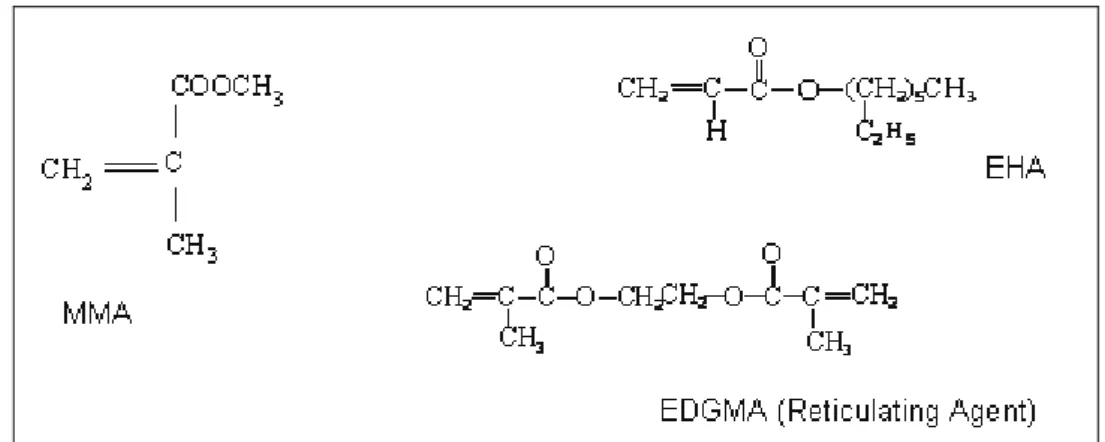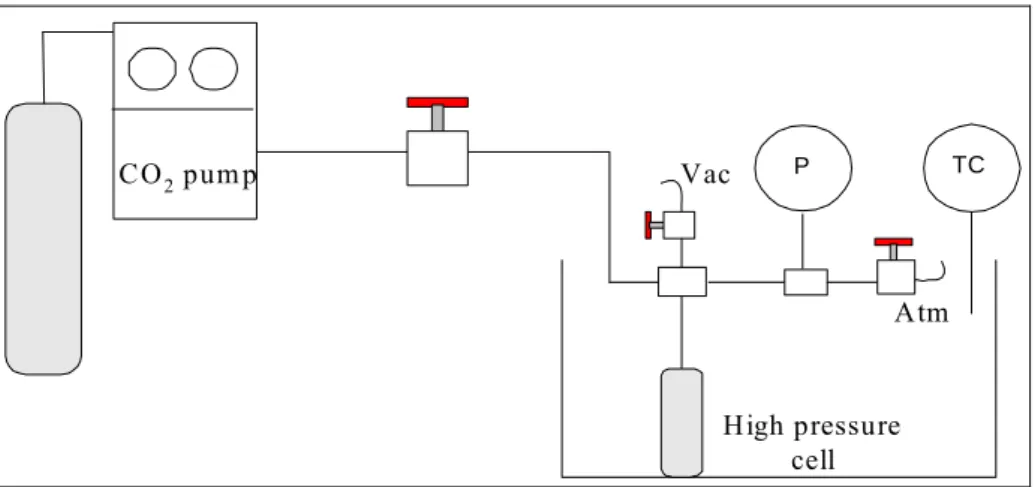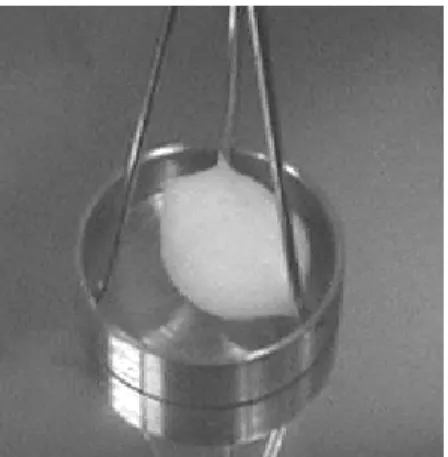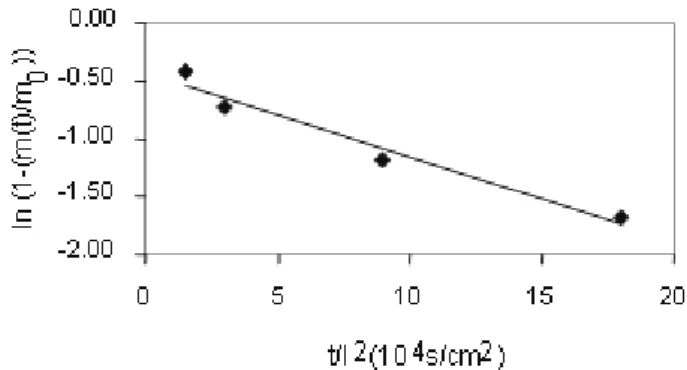ISSN 0104-6632 Printed in Brazil
www.abeq.org.br/bjche
Vol. 23, No. 02, pp. 191 - 196, April - June, 2006
Brazilian Journal
of Chemical
Engineering
SOLUBILITY OF DENSE CO
2
IN TWO
BIOCOMPATIBLE ACRYLATE
COPOLYMERS
A. R. C. Duarte
1, A. R. Sampaio de Sousa
1, H. C. de Sousa
2, M. H.M. Gil
2,
H. T. Jespersen
3and C. M.M. Duarte
1*1
Instituto de Biologia Experimental e Tecnológica, Aptd.12, 2780-901, Oeiras, Portugal Fone: + 351214469727, Fax: + 351214461161
E-mail: cduarte@itqb.unl.pt
2
Departamento de Engenharia Química, Universidade de Coimbra Pólo II, Pinhal de Marrocos, 3030-290, Coimbra, Portugal
3
Roskilde University, Institute 1, Center for Interdisciplinary Studies of Molecular Interactions, Universitetsvej 1, Postbox 260, DK-4000 Roskilde, Denmark
(Received: October 20, 2004 ; Accepted: January 9, 2006)
Abstract - Biocompatible polymers and copolymers are frequently being used as part of controlled delivery systems. These systems can be prepared using a “clean and environment friendly” technology like supercritical fluids. One great advantage of this process is that compressed carbon dioxide has excellent plasticizing properties and can swell most biocompatible polymeric matrixes, thus promoting drug impregnation processes. Mass sorption of two acrylate biocompatible copolymers contact with supercritical carbon dioxide is reported. Equilibrium solubility of dense carbon dioxidein poly(methylmethacrylate-co-ethylhexylacrylate) and poly(methylmethacrylate-co-ethylhexylacrylate-co-ethyleneglycoldimethacrylate) was studied by a static method at 10.0 MPa and 313 K. The reticulated copolymer had Fickean behavior and its diffusion coefficient was calculated, under operating conditions.
Keywords: Biocompatible acrylate; Supercritical fluids.
INTRODUCTION
Knowledge of diffusion in and through polymers is important, not only for the design of polymeric materials but also in a number of chemical processes, such as polycondensation, foaming, creation of polymer composites, impregnation, modification of polymers and many others (Jespersen, 2002).
This work is part of a research project designed for the study, development, preparation and characterization of controlled drug-release systems for ophthalmic applications. Determination of the best operating conditions involves the knowledge of the solubility of compressed carbon dioxide in the polymers.
The use of supercritical fluids as solvents offers the possibility to develop new “clean and environment friendly” processes. Compressed carbon dioxide has excellent plasticizing properties and can swell most biocompatible polymeric matrixes, thus promoting drug impregnation processes (Leino and Urtti, 1996). Biologically active or medical ingredients can be incorporated into polymer substrates without interference in the activity of the active substance because supercritical fluids process are at a low temperature (Clifford, 1999). Carbon dioxide is the most commonly used fluid due to its nontoxic properties and the low operating temperatures involved in supercritical processes (Tc = 304 K and Pc
The solubility of carbon dioxide in the matrixes was determined experimentally by a simple gravimetric procedure. Measurement of the diffusion coefficient for each matrix is described in this work.
The copolymers used are biocompatible ones and the main difference between them is the presence of
a reticulating agent in one of them. The chemical name of the reticulated copolymer is poly(methylmethacrylate-co-ethylhexylacrylate-co-ethyleneglycoldimethacrylate) and that of the non reticulated one is poly(methylmethacrylate-co-ethylhexylacrylate). The structure of the monomers is presented in Figure 1:
Figure 1: Monomer molecules of each copolymer studied
Table 1: Glass transition temperatures measured by DSC for the copolymers studied
Copolymer Tg (K)
Reticulated 236.88
Non reticulated 283.09
The mathematical theory of diffusion through isotropic substances was first studied by Fick (1855). This theory is based on the hypothesis that the rate of transfer of a diffusing substance through a unit cross-sectional area is proportional to the concentration gradient measured normal to the section, i.e.,
C
J D
x
∂
= − ∂ (1)
where D is the diffusion coefficient, C is the concentration of the diffusion substance, x is the coordinate perpendicular to the section and J is the flow per unit of cross-sectional area. This is known as Fick’s first law of diffusion.
The differential equation of diffusion, known as Fick’s second law, is derived from the first one and, if the diffusion is one-dimensional, i.e., if there is a gradient concentration in only one direction (along the x–axis), the amount of diffusing substance in the element is given by the equation:
2
2
C C
D
t x
⎛ ⎞
∂ = ⋅⎜∂ ⎟
⎜ ⎟
∂ ⎝∂ ⎠ (2)
From this equation, the time dependence of the material diffusing out of the sample, which in our case is a slab of thickness l, can be obtained (Jespersen, 2002; Crank, 1968; Shewmon, 1963), as follows:
2 2 n 1
D t l
0
2 2
n 0
8.M 1
M(t) e
(2.n 1)
⎡⎛ ⋅ + ⎞ ⎤
⎢ ⋅π ⋅ ⋅⎥
∞ ⎢⎜⎝ ⎟⎠ ⎥
⎣ ⎦
=
= ⋅
π
∑
+ (3)where M(t) is the mass of diffusing substance at time t and M0 is the mass of diffusing substance at t = ∞.
EXPERIMENTAL SECTION
Materials
dioxide (99.998 mol %) was supplied by Air Liquide.
Solubility Apparatus
The solubility of CO2 in the matrixes was
obtained using a simple gravimetric procedure. The high-pressure apparatus is schematically presented in Figure 2. The solubility measurements were performed in a manner similar to that described by Berens et al. (1992).
A new stainless steel cell was designed to perform these experiments. A quick opening cell was required in order to minimize the time between depressurization and acquisition of the data. The sorption of CO2 by the
polymer film was done in this high-pressure vessel followed by rapid depressurization of the sample. A compromise was established between the velocity of depressurization and the opening of the cell, so that carbon dioxide would not freeze inside.
The cell was immersed in a thermostatic water-bath, heated by means of a controller that maintained
the temperature within ± 0.1 K. The sample was loaded in a small stainless steel basket and the initial weight was recorded; the basket was placed inside the cell which was then evacuated for 15 minutes. Carbon dioxide was pumped into the cell using a pneumatic compressor until the desired pressure was attained. The pressure inside the cell was measured with a pressure transducer to within ± 0.05 MPa. The samples were submitted to high pressure for different periods of time from 10 minutes to 20 hours. After impregnation the vessel was quickly depressurized and the basket with the sample transferred to the balance for recording weight changes during desorption at atmospheric pressure.
To test and validate the new apparatus, some experiments were performed using PMMA at 10MPa and 313K. The calculation of the diffusion coefficient of this polymer proved to be of the same order of magnitude as that in the literature, 10-7 - 10-5 cm2/s, depending on the Mw of the polymer samples (Nikitin, 2002; Webb and Teja, 1999), thus validating our experimental method.
TC P
Atm Vac
High pressure cell
C O2 pum p
Figure 2: Schematic diagram of the high-pressure sorption apparatus (P – Pressure transducer; TC – Temperature controller)
RESULTS AND DISCUSSION
As stated, a series of experiments were performed for each copolymer at 10.0 MPa and 313 K and times of exposure to CO2 between 10 min and 20 hours. Poly(methylmethacrylate-co-ethylhexylacrylate)
When depressurized the non reticulated copolymer created a foam-like structure. This behavior was witnessed in a sapphire windowed visual cell. When pressure decreased bellow 2 MPa, a significant increase in volume was observed. Figure 3 shows the
aspect of the copolymer after 10 min of exposure to CO2 and depressurization to atmospheric pressure.
This behavior created experimental difficulties, namely a remarkable delay in the transfer of the sample to the balance when it was exposed to CO2 for
periods longer than to 2 hours; in this case a huge increase in the volume of the polymer was observed. An additional problem occurred with polymerization: there was still some residual monomer on the films produced that was only extracted with CO2 while the
Figure 3: Aspect of the copolymer after depressurization
Poly(methylmethacrylate-co-ethylhexylacrylate-co-ethyleneglycoldimethacrylate)
There was no significant difference between the original appearance of the reticulated copolymerand its appearance after exposure to CO2. A possible
explanation for this could be the presence of the reticulating agent that provides a more rigid structure to the copolymer.
In this case, desorption curves obtained for each experiment described the amount of CO2 inside the
sample as a function of time after the pressure release. As an example, Figure 4 presents the desorption curve for an exposure time of three hours.
Each data set, obtained for a different time of CO2
exposure, was correlated using equation 3, with n=10. The equilibrium mass of carbon dioxide, M, was determined from each desorption curve at the
release time T0. D is the desorption diffusion
coefficient of the sample, which for the experimental conditions studied, was found to be 1.9 * 10-5 cm2/s.
The sorption curve can be drawn from the values of M calculated for each set of experiments. In Figure 5, the sorption degree of the copolymer, defined as the ratio of mass M to the initial mass of
the sample, as a function of sorption time is presented.
The experimental error associated with each sorption point is less than 6%.
After 3 hours of pressurization the reticulated copolymer reached the maximum sorption capacity, M0. The analytical solution of equation 2, which
describes the sorption process for moderate and longer times, is (Crank, 1968; Crank, 1975):
(
)
2 22 2 2
0 n 0
D 2n 1 t
M(t) 8 1
1 exp
M (2n 1) l
∞
=
⎛− ⋅ + ⋅π ⋅ ⎞
⎜ ⎟
= − ⎜ ⎟
π
∑
+ ⎝ ⎠(4)This equation can be simplified by truncating it at the first term in the summation:
2
2 2
0
M(t) 8 D t
1 exp
M l
⎛− ⋅ π ⋅ ⎞
= − ⋅ ⎜⎜ ⎟⎟
π ⎝ ⎠ (5)
The value of the sorption diffusion coefficient (7.7*10-7 cm2/s) was obtained from the slope of ln(1-(M(t)/M0))as a function of (t/l2), which is presented
in Figure 6.
Figure 5: Sorption curve of the reticulated polymer in terms of sorption degree
Figure 6: Sorption of carbon dioxide by the reticulated copolymer
CONCLUSIONS
In this study, sorption and diffusion of supercritical carbon dioxide by ethylhexylacrylate) and poly(methylmethacrylate-co-ethylhexylacrylate-co-ethyleneglycoldimethacrylate) were studied at 10.0 MPa and 313 K.
The non reticulated copolymer created a foam-like structure during depressurization whilst the appearance of the reticulated one was not significantly different from the original appearance. A possible explanation for the two different behaviors observed could be the presence of the reticulating agent in one of them. This molecule provided a more rigid structure to the copolymer, preventing such a huge increase volume of the sample.
The reticulated copolymer follows the Fickean diffusion equation and the desorption and sorption diffusion coefficients were calculated and found to be about 40% (wt.%), 1.9 x 10-5 and 7.7 x 10-7 cm2/s, respectively. The maximum sorption capacity was determined and found to be about 40% (wt.%) achieved after 3 hours of exposure of the copolymer to carbon dioxide.
ACKNOWLEDGEMENTS
Ana Rita C. Duarte is grateful for the financial support in the form of grant SFRH/BD/10780/ 2002.
This work was financially supported by FCT-MCES and FEDER, Portugal, under contract POCTI/FCB/38213/2001.
NOMECLATURE
Tc critical temperature (K)
Pc critical pressure (MPa)
J flow per unit of
cross-sectional area (mol/s.cm
2)
D diffusion coefficient (cm2/s)
C concentration of diffusing
substance (mol/cm
3)
x coordinate perpendicular to
the section (cm
2)
t time (s)
M(t) mass of diffusing substance
at time t (g)
M0
mass of diffusing substance
at time t = ∞ (g)
l thickness of the sample (cm)
Tg glass transition temperature) (K
T0 release time (s)
M mass of diffusing substance
at T0
(g)
REFERENCES
Berens, A. R., Huvard, G. S., Korsmeyer, R. W., Kunig, F. W., Application of Compressed Carbon Dioxide in the Incorporation of Additives into Polymers. J. of Applied Polymer Science, 46, pp. 231-242 (1992).
Clifford, T., Fundamentals of Supercritical Fluids, Oxford University Press, N.Y. (1999).
Crank, J., Diffusion in Polymers, Academic Press, London (1968).
Science Publications, Oxford (1975).
Jespersen, H. T., Studies on Sorption and Modification of Polymer Films in Supercritical Carbon Dioxide, Master’s Thesis, University of Copenhagen (2002).
Leino, M. and Urtti, A., Ocular Therapeutics and Drug Delivery: A Multi-disciplinary Approach, pp.245 (1996).
Mariz, M., Preparação de uma lente intra-ocular dotada de um sistema de libertação controlada de fármaco, Master’s Thesis, Universidade de Coimbra (1999).
McHugh, M. A. and Krukonis, V. J., Supercritical
Fluid Extraction: Principles and Practice, Butterworths, Boston (1986).
Nikitin, L. N., Said-Galiyev, E. E., Vinokur, R. A., Khokhlov, A. R., Gallyamov, M. O., Schaumburg, K., Poly(methyl methacrylate and Poly(butyl methacrylate) Swelling in Supercritical Carbon Dioxide, Macromolecules, 35, pp.934-940 (2002) .
Shewmon, P. G., Diffusion in Solids, McGraw Hill, New York (1963).



